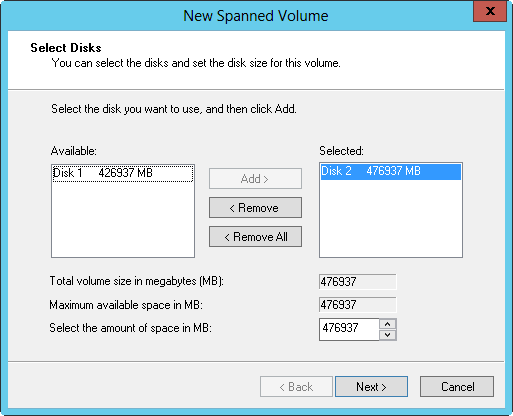Книга: Windows Server 2012 R2 Storage, Security, & Networking Pocket Consultant
Creating volumes and volume sets
Creating volumes and volume sets
You can format simple volumes as exFAT, FAT, FAT32, or NTFS. To make management easier, you should format volumes that span multiple disks as NTFS, which enables you to expand the volume set if necessary. If you find you need more space on a volume, you can extend simple and spanned volumes by selecting an area of free space and adding it to the volume. You can extend a simple volume within the same disk, and you can also extend a simple volume onto other disks. When you do this, you create a spanned volume, which you must format as NTFS.
You create volumes and volume sets by following these steps:
1. In Disk Management’s Graphical View, press and hold or right-click an unallocated area, and then tap or click New Spanned Volume or New Striped Volume as appropriate. Read the Welcome page, and then tap or click Next.
2. You should get the Select Disks page, shown in Figure 2–2. Select the disks that you want to be part of the volume, and then size the volume segments on those disks.

FIGURE 2–2 On the Select Disks page, select disks to be a part of the volume, and then size the volume on each disk.
3. Available disks are shown in the Available list. If necessary, select a disk in this list, and then tap or click Add to add the disk to the Selected list. If you make a mistake, you can remove disks from the Selected list by selecting the disk, and then tapping or clicking Remove.
CAUTION The disk wizards in Windows Server 2012 R2 show both basic and dynamic disks with available disk space. If you add space from a basic disk, the wizard converts the disk to a dynamic disk before creating the volume set. Before tapping or clicking Yes to continue, be sure you really want to do this because it can affect how the disk is used by the operating system.
4. Select a disk in the Selected list, and then specify the size of the volume on the disk in the Select The Amount Of Space In MB box. The Maximum Available Space In MB box shows you the largest area of free space available on the disk. The Total Volume Size In Megabytes box shows you the total disk space selected for use with the volume. Tap or click Next.
TIP Although you can size a volume set any way you want, consider how you’ll use volume sets on the system. Simple and spanned volumes aren’t fault tolerant; rather than creating one monstrous volume with all the available free space, you might want to create several smaller volumes to help ensure that losing one volume doesn’t mean losing all your data.
5. Specify whether you want to assign a drive letter or path to the volume, and then tap or click Next. You use the available options as follows:
? Assign The Following Drive Letter To assign a drive letter, choose this option, and then select an available drive letter in the list provided.
? Mount In The Following Empty NTFS Folder To assign a drive path, choose this option, and then type the path to an existing folder on an NTFS drive, or tap or click Browse to search for or create a folder.
? Do Not Assign A Drive Letter Or Drive Path To create the volume without assigning a drive letter or path, choose this option. You can assign a drive letter or path later if necessary.
6. Specify whether the volume should be formatted. If you elect to format the volume, set the following formatting options:
? File System Specifies the file system type, such as NTFS or ReFS.
? Allocation Unit Size Specifies the cluster size for the file system. This is the basic unit in which disk space is allocated. The default allocation unit size is based on the volume’s size and is set dynamically prior to formatting. Although you can’t change the default size if you select ReFS, you can set the allocation unit size to a specific value with other formats. If you use a lot of small files, you might want to use a smaller cluster size, such as 512 or 1,024 bytes. With these settings, small files use less disk space.
? Volume Label Specifies a text label for the partition. This label is the partition’s volume name.
? Perform A Quick Format Tells Windows to format without checking the partition for errors. With large partitions, this option can save you a few minutes. However, it’s more prudent to check for errors, which allows Disk Management to mark bad sectors on the disk and lock them out.
? Enable File And Folder Compression Turns on compression for the disk. Compression is transparent to users, and compressed files can be accessed just like regular files. If you select this option, files and directories on this drive are compressed automatically. For more information about compressing drives, files, and directories, see “Compressing drives and data” in Chapter 1. (For NTFS only)
7. Tap or click Next, and then tap or click Finish.
- Adjusting Volume
- Creating and scheduling backups with Wbadmin
- Understanding volume basics
- Deleting volumes and volume sets
- Managing volumes
- Разработка приложений баз данных InterBase на Borland Delphi
- Open Source Insight and Discussion
- Introduction to Microprocessors and Microcontrollers
- Chapter 6. Traversing of tables and chains
- Chapter 8. Saving and restoring large rule-sets
- Chapter 11. Iptables targets and jumps
- Chapter 5 Installing and Configuring VirtualCenter 2.0




